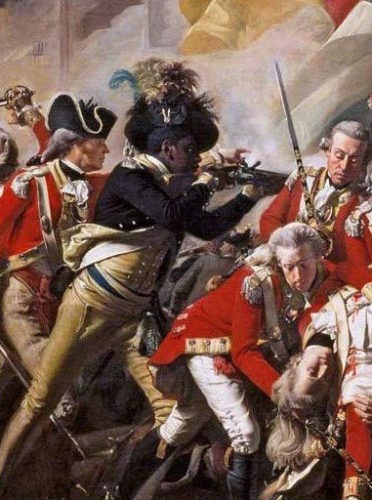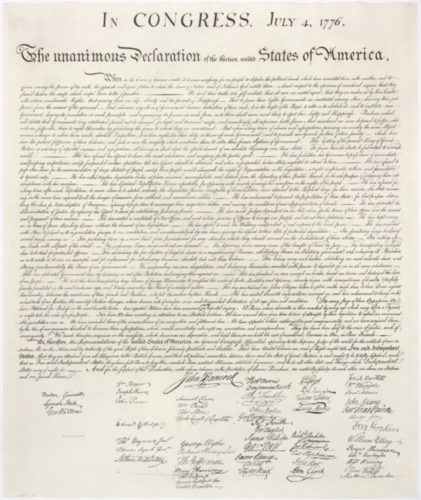Did a Fear of Slave Revolts Drive American Independence?
Share
Explore Our Galleries
Breaking News!
Today's news and culture by Black and other reporters in the Black and mainstream media.
Ways to Support ABHM?
By
Binghamton, N.Y. — FOR more than two centuries, we have been reading the Declaration of Independence wrong. Or rather, we’ve been celebrating the Declaration as people in the 19th and 20th centuries have told us we should, but not the Declaration as Thomas Jefferson, Benjamin Franklin and John Adams wrote it. To them, separation from Britain was as much, if not more, about racial fear and exclusion as it was about inalienable rights.
The Declaration’s beautiful preamble distracts us from the heart of the document, the 27 accusations against King George III over which its authors wrangled and debated, trying to get the wording just right. The very last one — the ultimate deal-breaker — was the most important for them, and it is for us: “He has excited domestic insurrections amongst us, and has endeavored to bring on the inhabitants of our frontiers, the merciless Indian savages, whose known rule of warfare is an undistinguished destruction of all ages, sexes and conditions.” In the context of the 18th century, “domestic insurrections” refers to rebellious slaves. “Merciless Indian savages” doesn’t need much explanation….
 Upon hearing the news that the Congress had just declared American independence, a group of people gathered in the tiny village of Huntington, N.Y., to observe the occasion by creating an effigy of King George. But before torching the tyrant, the Long Islanders did something odd, at least to us. According to a report in a New York City newspaper, first they blackened his face, and then, alongside his wooden crown, they stuck his head “full of feathers” like “savages,” wrapped his body in the Union Jack, lined it with gunpowder and then set it ablaze.
Upon hearing the news that the Congress had just declared American independence, a group of people gathered in the tiny village of Huntington, N.Y., to observe the occasion by creating an effigy of King George. But before torching the tyrant, the Long Islanders did something odd, at least to us. According to a report in a New York City newspaper, first they blackened his face, and then, alongside his wooden crown, they stuck his head “full of feathers” like “savages,” wrapped his body in the Union Jack, lined it with gunpowder and then set it ablaze.
The 27th and final grievance was at the Declaration’s heart (and on Long Islanders’ minds) because in the 15 months between the Battles of Lexington and Concord and independence, reports about the role African-Americans and Indians would play in the coming conflict was the most widely discussed news. And British officials all over North America did seek the aid of slaves and Indians to quell the rebellion.
A few months before Jefferson wrote the Declaration, the Continental Congress received a letter from an army commander that contained a shocking revelation: Two British officials, Guy Carleton and Guy Johnson, had gathered a number of Indians and begged them to “feast on a Bostonian and drink his blood.” Seizing this as proof that the British were utterly despicable, Congress ordered this letter printed in newspapers from Massachusetts to Virginia….
Adams, Franklin and Jefferson were essential in broadcasting these accounts as loudly as they could. They highlighted any efforts of British agents like Dunmore, Carleton and Johnson to involve African-Americans and Indians in defeating the Revolution….It was a very rare week in 1775 and 1776 in which Americans would open their local paper without reading at least one article about British officials “whispering” to Indians or “tampering” with slave plantations.
 So when the crowd in Huntington blackened the effigy’s face and stuffed its head with feathers before setting it on fire, they were indeed celebrating an independent America, but one defined by racial fear and exclusion. Their burning of the king and his enslaved and native supporters together signified the opposite of what we think of as America. The effigy represented a collection of enemies who were all excluded from the republic born on July 4, 1776.
So when the crowd in Huntington blackened the effigy’s face and stuffed its head with feathers before setting it on fire, they were indeed celebrating an independent America, but one defined by racial fear and exclusion. Their burning of the king and his enslaved and native supporters together signified the opposite of what we think of as America. The effigy represented a collection of enemies who were all excluded from the republic born on July 4, 1776.
This idea — that some people belong as proper Americans and others do not — has marked American history ever since…. All the African-Americans and Indians who supported the revolution — and lots did — were no match against the idea that they were all “merciless savages” and “domestic insurrectionists.” Like the people of Huntington, Americans since 1776 have operated time and time again on the assumption that blacks and Indians don’t belong in this republic. This notion comes from the very founders we revere this weekend. It haunts us still.
Read the full article here.
More Breaking News here.










Comments Are Welcome
Note: We moderate submissions in order to create a space for meaningful dialogue, a space where museum visitors – adults and youth –– can exchange informed, thoughtful, and relevant comments that add value to our exhibits.
Racial slurs, personal attacks, obscenity, profanity, and SHOUTING do not meet the above standard. Such comments are posted in the exhibit Hateful Speech. Commercial promotions, impersonations, and incoherent comments likewise fail to meet our goals, so will not be posted. Submissions longer than 120 words will be shortened.
See our full Comments Policy here.